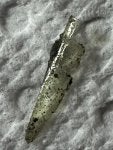So I bought a Glock 19 gen 5 on line as a FBI trade in
Looked like new so I cleaned it up, swapped in a new Glock threaded barrel, a performance trigger, had the slide cut for the new Holosun enclosed optic and took it out shooting at my place to zero in the optic.
right off the bat I had failure to eject and stove piping every other round, after the optic was sighted in I went back inside and stripped the slide down , be sure to see the picture of what I found. Right off the bat I could not get the extractor plunger pin out, it basically was seized in the bore, once I pried it far enough away from the extractor i could get the firing pin block out and then remove the extractor.
I had to get a punch and beat the extractor plunger pin out of the slide, there was a piece of clear plastic in the bore that was jamming the extractor plunger pin, be sure to see pic, I have no idea how anything like that could possibly get in there but it did.
I polished the pin and checked the bore, replaced the extractor claw and I now have a excellent shooting Glock 19
Looked like new so I cleaned it up, swapped in a new Glock threaded barrel, a performance trigger, had the slide cut for the new Holosun enclosed optic and took it out shooting at my place to zero in the optic.
right off the bat I had failure to eject and stove piping every other round, after the optic was sighted in I went back inside and stripped the slide down , be sure to see the picture of what I found. Right off the bat I could not get the extractor plunger pin out, it basically was seized in the bore, once I pried it far enough away from the extractor i could get the firing pin block out and then remove the extractor.
I had to get a punch and beat the extractor plunger pin out of the slide, there was a piece of clear plastic in the bore that was jamming the extractor plunger pin, be sure to see pic, I have no idea how anything like that could possibly get in there but it did.
I polished the pin and checked the bore, replaced the extractor claw and I now have a excellent shooting Glock 19






